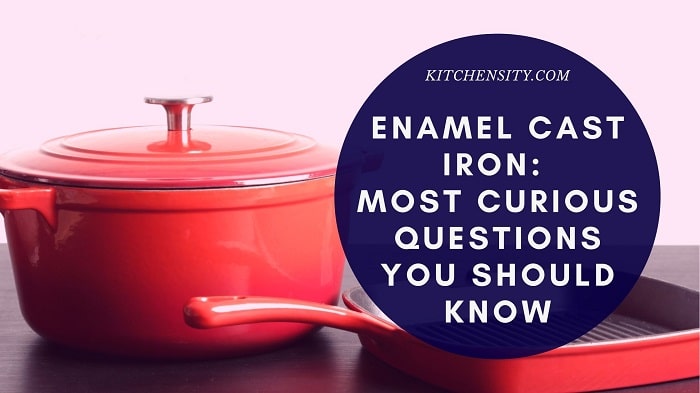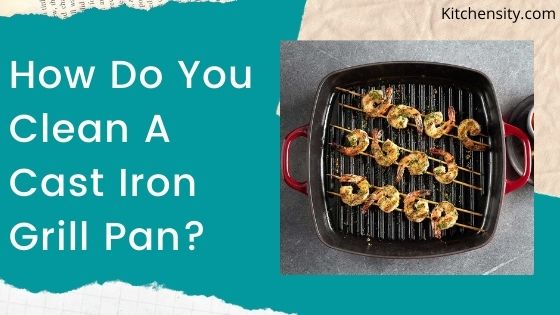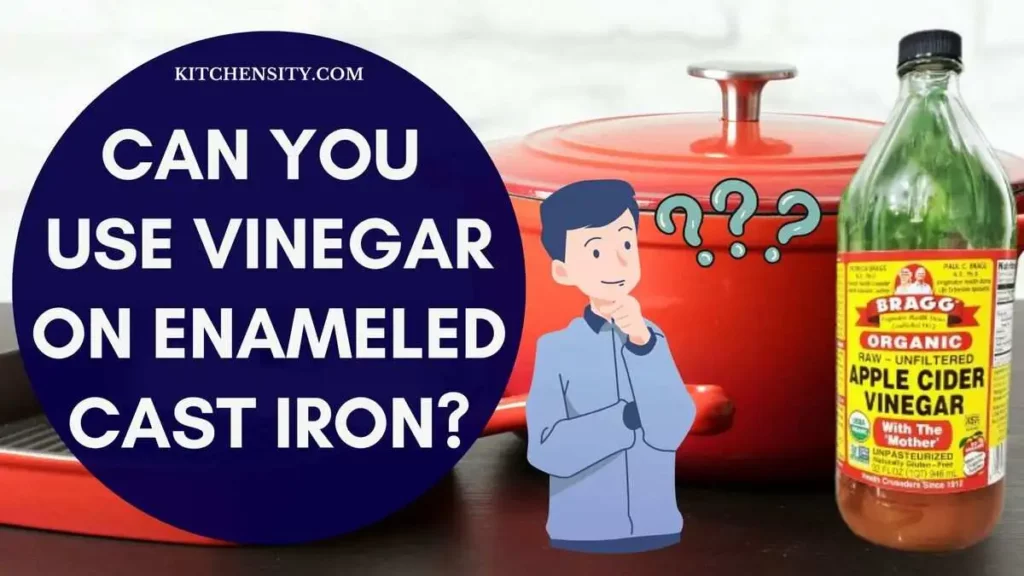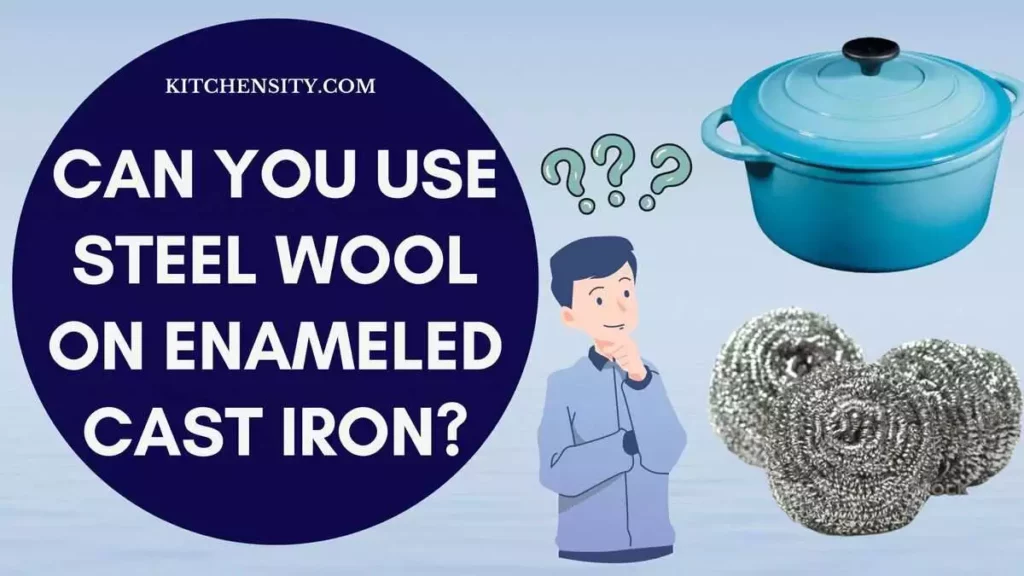Cast iron pans are renowned for their durability, heat retention, and even heat distribution. They have been a staple in kitchens for generations, standing the test of time.
However, over time, cast iron pans can develop rust, which raises concerns about their safety for cooking.
In this article, we will explore whether it is safe to cook in a rusty cast iron pan and provide the reasons behind rust formation, its impact on food, and the best practices for dealing with rusty cast iron pans.
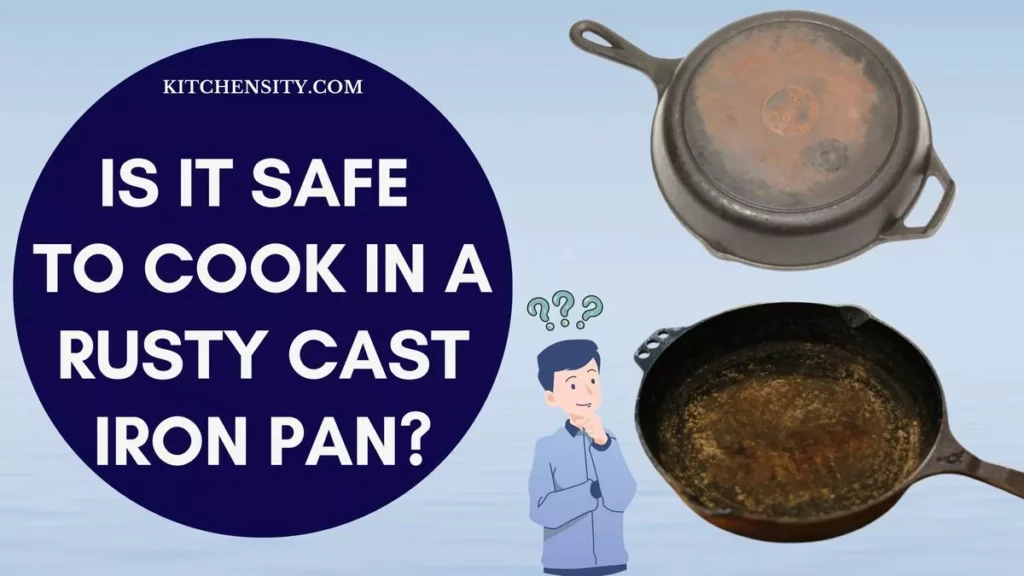
Table of Contents
- 1 Is It Safe To Cook In A Rusty Cast Iron Pan?
- 2 Understanding Rusty Cast Iron Pans
- 3 Potential Risks Of Using A Rusty Cast Iron Pan
- 4 Why Did My Cast Iron Skillet Rust?
- 5 How To Get Rid Of Rust On Cast Iron?
- 6 How To Prevent Rust Formation On Cast Iron Pans?
- 7 Tips For Safe Cooking With Cast Iron
- 8 Final Verdict
- 9 YOU MAY ALSO LIKE
- 10 FAQs
- 10.1 Is Rust In Cast Iron Pan Harmful?
- 10.2 Can You Cook In A Rusted Cast Iron Pan?
- 10.3 Does Heat Remove Rust From Cast Iron?
- 10.4 What To Do If Cast Iron Starts To Rust?
- 10.5 Can I Remove Rust From A Cast Iron Pan Using Abrasive Materials?
- 10.6 Is It Safe To Use A Rusty Cast Iron Pan After Removing The Rust?
- 10.7 How Often Should I Season My Cast Iron Pan?
- 10.8 Can I Cook Acidic Foods In A Cast Iron Pan?
- 10.9 How Can I Prevent My Cast Iron Pan From Rusting In The Future?
- 10.10 Is It Harmful To Ingest Rust From A Cast Iron Pan?
Is It Safe To Cook In A Rusty Cast Iron Pan?
Cooking in a rusty cast iron pan can pose risks to your health. When rust forms on the surface of the pan, it can contaminate the food being cooked. Rust contains iron oxide, which is not suitable for human consumption. It can cause health problems, particularly for individuals with iron-related disorders or allergies.
Moreover, cooking in a rusty pan may affect the taste and quality of the food. The rust can impart an unpleasant metallic flavor to your dishes, compromising their overall appeal.
Also Read – why do cast iron pans crack?
Understanding Rusty Cast Iron Pans
Cast iron pans are susceptible to rust primarily because of their iron composition and their exposure to moisture. Iron is a metal that naturally reacts with oxygen and moisture in the presence of air, leading to the formation of iron oxide, commonly known as rust.
- The protective layer of seasoning on a cast iron pan plays a crucial role in preventing rust.
- Seasoning refers to the process of coating the surface of the pan with a thin layer of oil or fat and heating it. This creates a polymerized layer that acts as a barrier between the iron and the surrounding environment.
- The seasoning layer not only protects the pan from rust but also provides a non-stick surface for cooking.
However, over time, the seasoning on a cast iron pan can wear off or become damaged due to various factors such as frequent use, abrasive cleaning, or exposure to acidic ingredients.
When the seasoning layer is compromised, the iron beneath is exposed to oxygen and moisture, initiating the rusting process.
- Rust typically manifests as a reddish-brown discoloration on the surface of the pan.
- It may appear as specks, or patches, or even cover the entire surface, depending on the extent of rusting.
- If left unaddressed, rust can continue to spread and degrade the pan’s quality and performance.
It’s important to note that not all discoloration on a cast iron pan is necessarily rust. Sometimes, the pan may develop a dark, blackish patina, which is a desirable characteristic.
This patina forms as a result of the seasoning process and is a sign of a well-seasoned and well-maintained pan. It provides additional protection against rust and enhances the pan’s non-stick properties.
Also Read – Is Enameled Cast Iron Cookware Safe?
Potential Risks Of Using A Rusty Cast Iron Pan
Cast iron is a non-toxic material, and rust itself is not harmful if ingested in small quantities. However, cooking in a rusty cast iron pan can affect the taste and quality of the food, and it may also pose certain risks.
Here are some potential risks of using a rusty cast iron pan:
Food Contamination
- One of the significant risks of using a rusty cast iron pan is food contamination.
- When rust forms on the surface of the pan, it can contaminate the food being cooked.
- Rust contains iron oxide, which is not suitable for human consumption. Ingesting rust particles can potentially cause health problems, especially for individuals with iron-related disorders or allergies.
- It’s important to ensure that the cooking surface of the cast iron pan is free from rust to avoid any contamination.
Iron Overload
- Another risk associated with using a rusty cast iron pan is the possibility of iron overload.
- Rust is composed of iron oxide, and cooking in a rusty pan can lead to the transfer of iron particles into the food.
- While iron is an essential mineral for the body, excessive iron intake can be harmful, particularly for individuals with certain health conditions such as hemochromatosis, a disorder characterized by the body’s inability to regulate iron absorption.
- It’s crucial to avoid consuming excess iron through rusty cookware to maintain a healthy balance.
Altered Taste
- Cooking in a rusty cast iron pan can also result in an altered taste of the food.
- The rust on the pan’s surface can impart an unpleasant metallic flavor to the dishes. This can significantly impact the overall taste and quality of the food being prepared.
- Rusty pans may also affect the appearance of cooked food, making it less appetizing.
- It’s advisable to cook with a rust-free cast iron pan to ensure the desired flavors and presentation of your meals.
Also Read – Why Griswold Cast Iron Is So Expensive?
Why Did My Cast Iron Skillet Rust?
There are several reasons why a cast iron skillet may rust. Here are some common reasons why cast iron skillets can rust:
- Moisture Exposure:
- Moisture is one of the primary culprits behind rust formation on cast iron skillets.
- When the skillet comes into contact with water or any other form of moisture and is not properly dried, it creates an environment conducive to rust development.
- This can happen during the cleaning process or if the skillet is stored in a humid area without proper ventilation.
- Damaged Seasoning:
- The seasoning on a cast iron skillet refers to the layer of polymerized oil or fat that forms a protective coating on its surface.
- If the seasoning is scratched, chipped, or damaged, it exposes the iron underneath to moisture and air, leading to rust formation.
- Harsh cleaning methods, abrasive cleaning tools, or using metal utensils can all contribute to damaging the seasoning.
- Improper Storage:
- Storing a cast iron skillet improperly can contribute to rust.
- If the skillet is not thoroughly dried before being put away or is stacked with other cookware while still damp, moisture can accumulate and promote rust formation.
- It’s important to ensure the skillet is completely dry and stored in a dry location to prevent rust.
- Lack Of Regular Use:
- Cast iron skillets benefit from regular use and exposure to heat.
- When a skillet is not used frequently, the protective seasoning layer can weaken or break down over time, making it more susceptible to rust.
- Regular cooking and proper maintenance help maintain the seasoning and prevent rust from taking hold.
- Highly Acidic Foods:
- Cooking highly acidic foods, such as tomatoes or citrus-based dishes, in a cast iron skillet can potentially contribute to rust formation.
- Acidic ingredients can react with the iron surface, causing the seasoning to deteriorate and exposing the skillet to moisture, leading to rust.
- It’s recommended to use enameled cast iron or stainless steel cookware for highly acidic foods.
Also Read – Can You Use Olive Oil To Season Cast Iron Pans?
How To Get Rid Of Rust On Cast Iron?
If your cast iron pan has already developed rust, don’t worry. It is possible to remove rust and restore the pan to its former glory. Here’s how you can do it:
- Gather The Necessary Supplies: You will need a stiff brush or sponge, mild dish soap, water, a cloth or paper towel, cooking oil, salt, and optionally, vinegar.
- Scrubbing With Salt And Oil: Make a paste using coarse salt and a small amount of cooking oil. Scrub the rusty areas of the pan gently using a cloth or brush. The salt acts as an abrasive to remove the rust, while the oil helps condition the pan.
- Wash The Pan: Once you have removed as much rust as possible, wash the pan with mild dish soap and warm water. Use a sponge or cloth to clean the entire surface of the pan, including the rusted areas.
- Dry The Pan Thoroughly: After washing, use a cloth or paper towel to dry the pan completely. Ensure that no moisture is left on the surface, as this can contribute to rust formation.
- Apply Cooking Oil: Take a small amount of cooking oil, such as vegetable oil or flaxseed oil, and apply it to the entire surface of the pan. Use a cloth or paper towel to spread the oil evenly.
- Season The Pan:
- Preheat your oven to a high temperature, typically around 400°F (200°C).
- Place the oiled cast iron pan upside-down on the middle rack of the oven, with a baking sheet or aluminum foil placed on the rack below to catch any drips.
- Bake the pan for about an hour to allow the oil to polymerize and create a protective seasoning layer.
- Repeat If Necessary: If the rust is not entirely removed after the first attempt, you can repeat the process of scrubbing, washing, and seasoning until the pan is rust-free.
Also Read – Do You Need To Season Enameled Cast Iron?
Optional Method For Removing Rust Using Vinegar
- Create A Vinegar Solution: If the rust is stubborn and difficult to remove, you can create a vinegar solution. Mix equal parts of water and vinegar in a container large enough to submerge the pan.
- Soak The Pan: Place the rusted cast iron pan in the vinegar solution and let it soak for a few hours or overnight. The acidity of the vinegar will help dissolve the rust.
- Scrub And Wash: After soaking, scrub the pan again using a stiff brush or sponge to remove any remaining rust. Rinse the pan thoroughly with water and wash it with mild dish soap.
- Dry And Season: Dry the pan completely with a cloth or paper towel, then follow the seasoning process described in steps 5 and 6 of the previous method.
By following these steps, you can effectively remove rust from your cast iron pan and restore it to its original condition.
Remember to always maintain and season your cast iron pan regularly to prevent rust formation in the future.
Also Read – Can You Use Enameled Cast Iron On A Glass Cooktop?
How To Prevent Rust Formation On Cast Iron Pans?
Preventing rust formation on a cast iron pan is crucial to maintain its quality and longevity. Here are some detailed steps you can take to prevent rust:
- Proper Seasoning:
- Seasoning your cast iron pan is essential for creating a protective layer that helps prevent rust.
- To season your pan, start by cleaning it thoroughly with mild dish soap and water. Rinse and dry the pan completely.
- Next, apply a thin layer of cooking oil or shortening to the entire surface, including the handle.
- Use a cloth or paper towel to spread the oil evenly. Place the pan upside-down on the middle rack of a preheated oven (around 400°F or 200°C) and bake it for about an hour.
- This process will polymerize the oil, creating a non-stick surface and providing protection against moisture.
- Thorough Drying:
- After each use and cleaning, ensure your cast iron pan is thoroughly dried.
- Use a clean cloth or paper towel to remove any moisture from the surface and crevices.
- Avoid air drying the pan, as it can allow moisture to linger and contribute to rust formation.
- Avoid Prolonged Exposure To Moisture:
- Moisture is the primary catalyst for rust development.
- Avoid leaving your cast iron pan in contact with water or other liquids for extended periods.
- If you wash the pan, dry it immediately and store it in a dry location.
- Proper Storage: Store your cast iron pan in a dry place to minimize exposure to humidity. You can place a paper towel inside the pan to absorb any residual moisture and prevent condensation.
- Use Regularly: Regular use of your cast iron pan helps maintain its seasoning and keeps the protective layer intact. The heat from cooking helps to remove any moisture and keeps the pan in good condition. If you have a cast iron pan that is not in frequent use, it is advisable to season it periodically to prevent rust formation.
- Avoid Harsh Cleaning Methods:
- When cleaning your cast iron pan, avoid using harsh abrasives, steel wool, or metal utensils that can damage the seasoning.
- Instead, opt for gentle scrubbing with a soft brush or sponge and mild dish soap.
- If there are stubborn food residues, you can use coarse salt as a natural abrasive.
Also Read – Can You Put Enamel Cast Iron In The Dishwasher?
Tips For Safe Cooking With Cast Iron
To ensure safe and enjoyable cooking experiences with your cast iron pan, consider the following tips:
- Monitor Seasoning:
- Regularly check the condition of the seasoning on your cast iron pan.
- Seasoning refers to the protective layer of polymerized oil or fat that prevents rust and provides a non-stick surface.
- If you notice any signs of the seasoning wearing off or becoming damaged, it’s important to reseason the pan. This will help maintain its integrity and prevent rust formation.
- Avoid High Heat:
- Excessive heat can cause a cast iron pan to warp or damage the seasoning.
- It’s recommended to use moderate heat settings when cooking with cast iron.
- Avoid subjecting the pan to sudden temperature changes as well, as this can lead to cracking.
- Gradual Heating And Cooling:
- To prevent damage, allow the cast iron pan to heat up gradually. Start with low to medium heat and gradually increase if necessary.
- Similarly, when removing the pan from heat, allow it to cool down naturally.
- Avoid placing a hot cast iron pan directly under cold water, as this can cause it to crack.
- Use Silicone Or Wooden Utensils:
- When cooking with a cast iron pan, it’s advisable to use silicone or wooden utensils.
- Metal utensils can scratch the seasoning and expose the iron surface, making it more prone to rust.
- Silicone or wooden utensils are gentler on the pan and help preserve the seasoning.
- Store With Care:
- Proper storage of a cast iron pan is crucial to prevent rust. Ensure that the pan is completely dry before storing it. Moisture can promote rust formation.
- To prevent scratching, you can place a protective layer, such as a cloth or paper towel, between stacked cast iron pans.
- Store the pan in a dry place with adequate ventilation.
Also Read – Can You Use Vinegar On Enameled Cast Iron?
Final Verdict
So, cooking in a rusty cast iron pan may affect the taste, appearance, and quality of your food. While small amounts of rust are generally not harmful, it is best to prevent rust formation or address the issue promptly.
By following proper preventive measures, removing rust when necessary, and re-seasoning the pan, you can ensure a safe and enjoyable cooking experience with your cast iron pan.
Remember, cast iron pans are durable and versatile cooking tools, but they require care and maintenance to keep them in optimal condition. With proper attention and timely rust prevention, your cast iron pan can continue to serve you well for years to come.
YOU MAY ALSO LIKE
- Can You Use Steel Wool On Enameled Cast Iron?
- Can You Put Enameled Cast Iron In The Oven?
- Enamel Cast Iron: Most Curious Questions You Should Know
- Does Enamel Cast Iron Chip?
- How To Clean A Cast Iron Grill Pan?
- How To Season And Clean Cast Iron Cookware?
- Cast Iron Skillet Gift Basket Ideas
- Why Does Food Stick To My Enamel Cast Iron?
- Best Enameled Cast Iron Cookware Sets
FAQs
-
Is Rust In Cast Iron Pan Harmful?
Yes, rust in a cast iron pan can be harmful as it can contaminate food, alter the taste, and potentially lead to iron overload if consumed in excessive amounts.
-
Can You Cook In A Rusted Cast Iron Pan?
It is not recommended to cook in a rusted cast iron pan as it can affect the taste and safety of the food. It’s best to address the rust issue before using the pan for cooking.
-
Does Heat Remove Rust From Cast Iron?
Heat alone does not remove rust from cast iron. Rust should be manually scrubbed off using appropriate techniques and cleaning agents, followed by reseasoning the pan to prevent further rust formation.
-
What To Do If Cast Iron Starts To Rust?
If a cast iron pan starts to rust, scrub the rust off using a stiff brush or scrubber, apply a vinegar soak if necessary, rinse, dry thoroughly, and reseason the pan to restore its protective coating. Regular maintenance and care can help prevent rust in the future.
-
Can I Remove Rust From A Cast Iron Pan Using Abrasive Materials?
It is not recommended to use abrasive materials, such as steel wool or harsh scouring pads, as they can damage the pan’s surface. Opt for non-abrasive methods like scrubbing with a stiff brush and using vinegar soaks.
-
Is It Safe To Use A Rusty Cast Iron Pan After Removing The Rust?
After successfully removing the rust and reseasoning the pan, it can be safe to use. However, ensure that the pan is thoroughly cleaned and seasoned to prevent any potential health risks.
-
How Often Should I Season My Cast Iron Pan?
It is advisable to season your cast iron pan regularly, especially after removing rust or when the seasoning starts to deteriorate. As a general guideline, season your pan every few months or as needed.
-
Can I Cook Acidic Foods In A Cast Iron Pan?
While limited use of acidic foods is generally fine, prolonged exposure to acidic ingredients can damage the seasoning and increase the risk of rust formation. It’s best to use alternative cookware for highly acidic dishes.
-
How Can I Prevent My Cast Iron Pan From Rusting In The Future?
To prevent rust formation, ensure your cast iron pan is thoroughly dried after each use and store it in a dry place. Regularly season the pan, avoid prolonged exposure to moisture, and practice proper cleaning techniques.
-
Is It Harmful To Ingest Rust From A Cast Iron Pan?
Ingesting small amounts of rust is generally not harmful. However, consuming large quantities of rust can cause digestive discomfort and may pose a choking hazard. It is best to prevent rust from forming or remove it before using the pan for cooking.
Katrina Smith is a seasoned expert with over 25 years of experience in all things related to cooking and the kitchen. As an avid cook and kitchen enthusiast, she is passionate about sharing her knowledge and expertise on cookware, kitchen appliances, kitchen tips, and kitchen staples.
Through her articles and reviews, Katrina aims to inspire and help others improve their cooking skills, experiment with different ingredients, and invest in quality cookware and appliances.

![How To Season And Clean Cast Iron Cookware? [4 Effective Ways] 3 How To Season And Clean Cast Iron Cookware](https://www.kitchensity.com/wp-content/uploads/2020/06/How-To-Season-And-Clean-Cast-Iron-Cookware.jpg)
